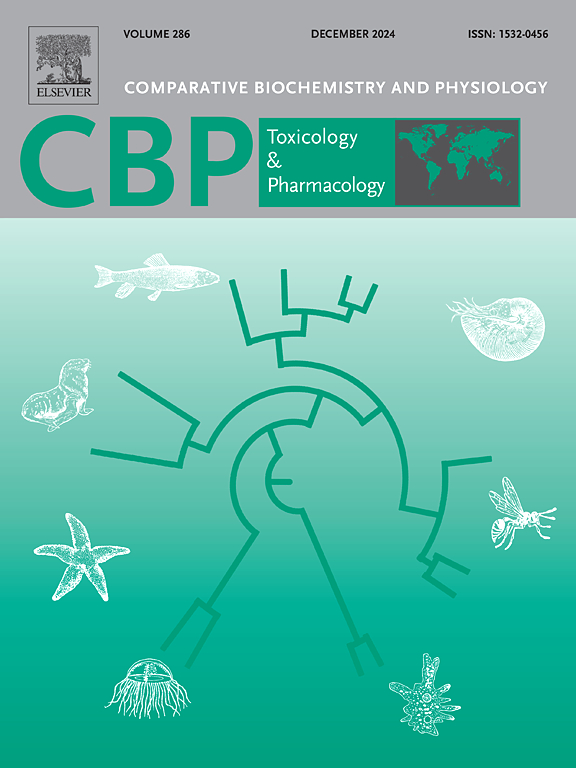Crotalus molossus复合体的毒液变异和个体发生变化:对成分、活性和抗蛇毒血清中和的见解。
IF 3.9
3区 环境科学与生态学
Q2 BIOCHEMISTRY & MOLECULAR BIOLOGY
Comparative Biochemistry and Physiology C-toxicology & Pharmacology
Pub Date : 2025-01-30
DOI:10.1016/j.cbpc.2025.110129
引用次数: 0
摘要
Crotalus molossus复合体由广泛分布在墨西哥的五到七个系统发育相关的黑尾响尾蛇谱系组成。虽然以前的研究已经注意到Crotalus molossus complex的特定谱系中的毒液变异,但对种间和个体发生的毒液变异的综合表征、它们的功能含义以及墨西哥抗蛇毒血清对这些变异的中和能力仍未得到充分研究。本文采用两种蛋白质组学方法对5个蛇颈蛇系(蛇颈蛇、蛇颈蛇、黑颈蛇、蛇颈蛇和蛇颈蛇)的蛇颈蛇复合物进行了分析,分析了不同大小个体毒液中毒素的数量及其相对丰度。所有五个血统都经历了与蛇长度相关的个体发生毒液组成变化。然而,个体发生转变的模式在不同谱系之间有所不同。在一些谱系中,这些变化导致蛋白水解、磷脂酶A2和纤维蛋白原溶解活性的显著差异。较小的basiliscus、c.m. nigrescens和c.m. oaxacus个体的毒液在小鼠中的LD50值较低(更致命)。而在哺乳动物(小鼠)模型中,黑黑c.m.(幼虫和成虫)和瓦axacus(成虫)的毒液致死率要比在爬行动物(鬣蜥)模型中高几倍。Antivipmyn®对毒液池表现出不同的中和效力。总体而言,我们的研究结果表明,即使在密切相关的响尾蛇谱系中,毒液表型也可能存在很大差异,从而影响它们的功能和抗蛇毒血清中和的功效。本文章由计算机程序翻译,如有差异,请以英文原文为准。

Venom variation and ontogenetic changes in the Crotalus molossus complex: Insights into composition, activities, and antivenom neutralization
The Crotalus molossus complex consists of five to seven phylogenetically related lineages of black-tailed rattlesnakes widely distributed in Mexico. While previous studies have noted venom variation within specific lineages of the Crotalus molossus complex, a comprehensive characterization of interspecific and ontogenetic venom variations, their functional implications, and the neutralizing ability of the Mexican antivenom against these variants remains largely unexamined. Herein, using two proteomic approaches for five lineages (C. basiliscus, C. m. molossus, C. m. nigrescens, C. m. oaxacus, and C. ornatus) of the C. molossus complex we characterized the number of toxins and their relative abundance in the venom of individuals of varying sizes. All five lineages undergo ontogenetic venom composition shifts associated with snake length. However, the pattern of ontogenetic shifts varied among lineages. In some lineages, these shifts led to significant differences in proteolytic, phospholipase A2, and fibrinogenolytic activities. Venom in smaller C. basiliscus, C. m. nigrescens, and C. m. oaxacus individuals had lower LD50 values (more lethal) in mice. Whereas the venom lethality of C. m. nigrescens (both juvenile and adult) and C. m. oaxacus (adult) was several times higher in a mammalian (mouse) model than in a reptilian (iguana) model. Antivipmyn® showed different neutralizing potencies toward venom pools. Overall, our results indicated that even among closely related rattlesnake lineages, venom phenotypes may vary greatly, impacting their function and the efficacy of antivenom neutralization.
求助全文
通过发布文献求助,成功后即可免费获取论文全文。
去求助
来源期刊
CiteScore
7.50
自引率
5.10%
发文量
206
审稿时长
30 days
期刊介绍:
Part C: Toxicology and Pharmacology. This journal is concerned with chemical and drug action at different levels of organization, biotransformation of xenobiotics, mechanisms of toxicity, including reactive oxygen species and carcinogenesis, endocrine disruptors, natural products chemistry, and signal transduction with a molecular approach to these fields.

 求助内容:
求助内容: 应助结果提醒方式:
应助结果提醒方式:


